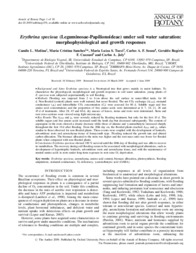Erythrina speciosa (Leguminosae-Papilionoideae) under soil water saturation: morphophysiological and grouwth responses.
Erythrina speciosa (Leguminosae-Papilionoideae) under soil water saturation: morphophysiological and grouwth responses.
Author(s): MEDINA, C. L.; SANCHES, M. C.; TUCCI, M. L. S.; SOUSA, C. A. F. de; CUZZUOL, G. R. F.; JOLY, C. A.
Summary: Background and Aims Erythrina speciosa is a Neotropical tree that grows mainly in moist habitats. To characterize the physiological, morphological and growth responses to soil water saturation, young plants of E. speciosa were subjected experimentally to soil flooding. Methods Flooding was imposed from 2 to 4 cm above the soil surface in water-filled tanks for 60 d. Non-flooded (control) plants were well watered, but never flooded. The net CO2 exchange (ACO2), stomatal conductance (gs) and intercellular CO2 concentration (Ci) were assessed for 60 d. Soluble sugar and free amino acid concentrations and the proportion of free amino acids were determined at 0, 7, 10, 21, 28 and 45 d of treatments. After 28, 45 and 60 d, dry masses of leaves, stems and roots were determined. Stem and root cross-sections were viewed using light microscopy. Key Results The ACO2 and gs were severely reduced by flooding treatment, but only for the first 10 d. The soluble sugars and free amino acids increased until the tenth day but decreased subsequently. The content of asparagine in the roots showed a drastic decrease while those of alanine and g-aminobutyric increased sharply throughout the first 10 d after flooding. From the 20th day on, the flooded plants reached ACO2 and gs values similar to those observed for non-flooded plants. These events were coupled with the development of lenticels, adventitious roots and aerenchyma tissue of honeycomb type. Flooding reduced the growth rate and altered carbon allocation. The biomass allocated to the stem was higher and the root mass ratio was lower for flooded plants when compared with non-flooded plants. Conclusions Erythrina speciosa showed 100% survival until the 60th day of flooding and was able to recover its metabolism. The recovery during soil flooding seems to be associated with morphological alterations, such as development of hypertrophic lenticels, adventitious roots and aerenchyma tissue, and with the maintenance of neutral amino acids in roots under long-term exposure to root-zone O2 deprivation.
Publication year: 2009
Types of publication: Journal article
Unit: Embrapa Mid-North
Keywords: Aminoácido, Biomassa, Fotossíntese
Observation
Some of Embrapa's publications are published as ePub files. To read them, use or download one of the following free software options to your computer or mobile device. Android: Google Play Books; IOS: iBooks; Windows and Linux: Calibre.
Access other publications
Access the Agricultural Research Database (BDPA) to consult Embrapa's full library collection and records.
Visit Embrapa Bookstore to purchase books and other publications sold by Embrapa.

